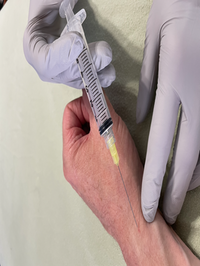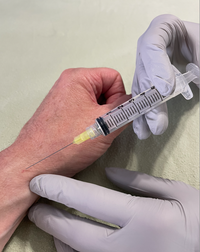Perineural Injection Treatment (PIT) is a minimally invasive natural approach to treating pain.
This treatment is mainly used to target neuropathic pain, which is caused by inflamed or injured nerves. Neuropathic pain can be sharp, aching, nagging, or burning.
Dr. McReynolds learned PIT directly from Dr. John Lyftogt (pronounced "Liftoff"), a New Zealand physician whole developed PIT. Using a pharmaceutical-grade 5% dextrose solution, injections are given just beneath the skin along the cutaneous nerve pathway. These nerves are not visible on x-ray, CT-scan, MRI, or ultrasound, but can contribute significantly to pain. The solution assists to heal injures, nerves, restore tissue function, and eliminate pain.
How PIT Works:
1)When nerves become injured, they begin misfiring and send messages to the brain, even when nerves aren’t stimulated. The dextrose solution disrupts this misfiring; this calms down the inflammation around the nerve and allows healing.
2)Cutaneous nerves can get trapped from tissue swelling. When the 5% dextrosue solution is injected, this can relieve pressure on the trapped nerves and reduces pain and inflammation.
3)Chronic inflammaion can cause glucopenia (low glucose levels around the nerves). Injecting glucose around the neves can give the glucose and energy the nerve needs to heal and function correctly.
Conditions Treated with PIT:
- Achilles tendonitis
- Arthritis
- Back pain
- Carpal tunnel
- Golfer’s elbow
- Headaches
- Herniated disc
- Joint pain
- Migraines
- Neck pain
- Osteoarthritis
- Overuse Injuries
- Patellar tendinitis
- Pinched nerve
- Plantar fasciitis
- Repetitive strain injuries
- Rotator cuff tear pain
- Sacral-Iliac (SI) pain
- Sciatica
- Scoliosis Pain
- Shoulder Pain
- Sports injuries
- Tendinitis
- Tendinosis
- Tennis elbow
- TMJ dysfunction
- Whiplash
Frequently Asked Questions
What are the risks and side effects?
Anytime a needle is placed in the body, there is a risk of infection, bleeding, bruising, and worsened pain. These risks are very rare due to the antiseptic measures and the use of very thin needles. Temporary histamine release may cause welts at injection sites. Allergic reactions are rare.
How many treatments will I need?
While each person and condition are different, the average number of treatments
required for most patients is six to eight. Each treatment aims to stop the
pain. Patients are often surprised when
they leave the office with minimal or no pain after their first treatment. Pain relief
may last hours, days, or weeks. After
each treatment, pain relief should last longer.
These injections are usually performed every 1-3 weeks.
How soon can I return to activity?
One of the significant benefits of perineural injection therapy is that there
is no downtime, and you can return to activity immediately after the
injections.
Does insurance cover this procedure?
Insurance does not cover this procedure, nor is Dr. McReynolds contracted with any insurance companies.

